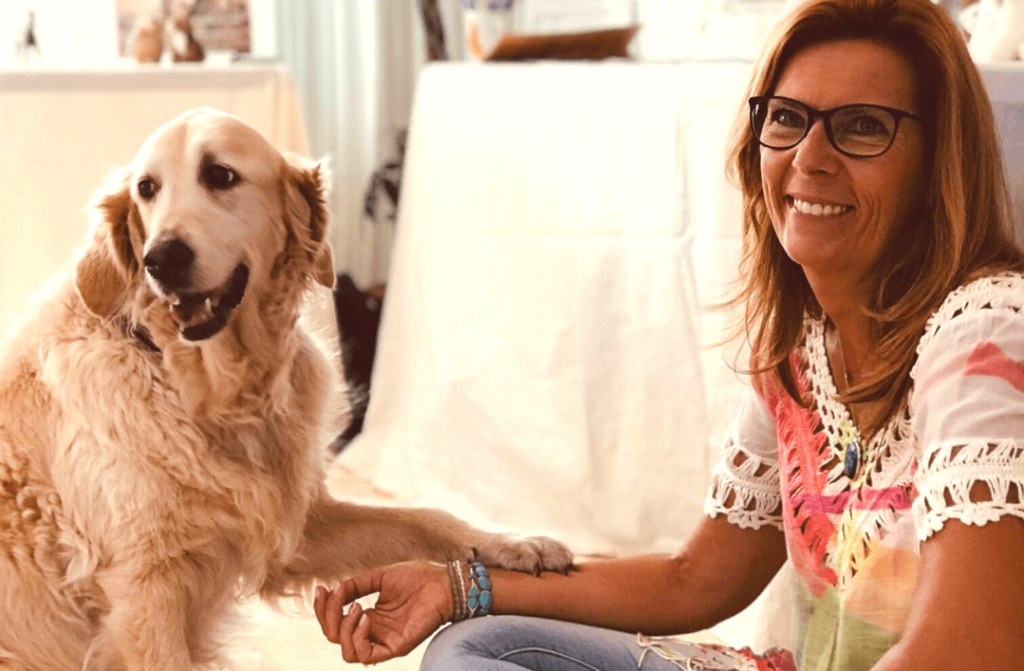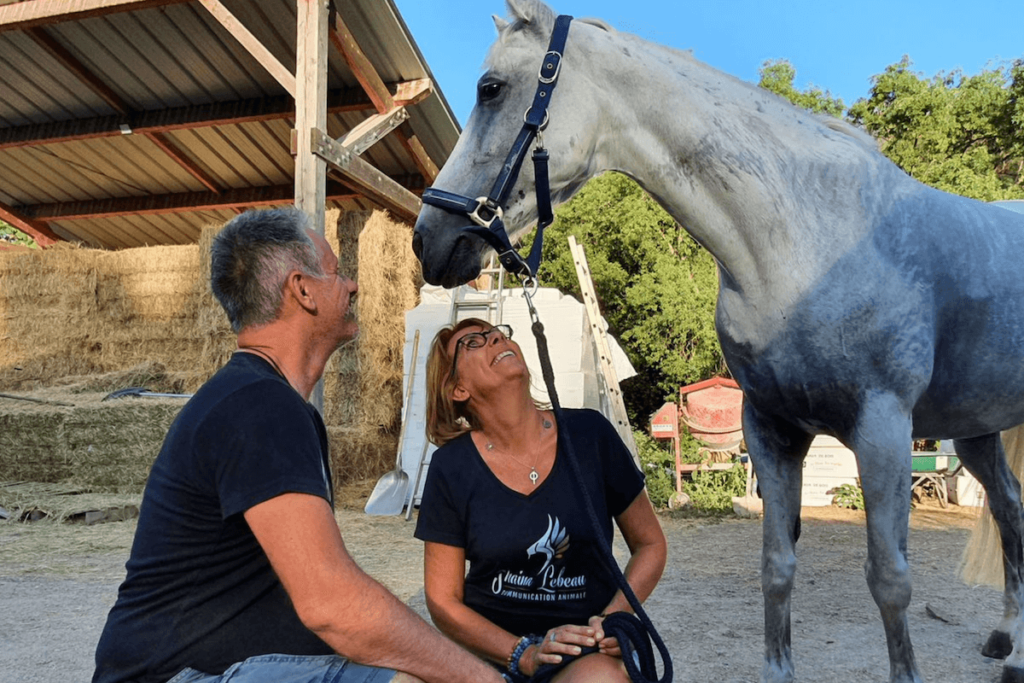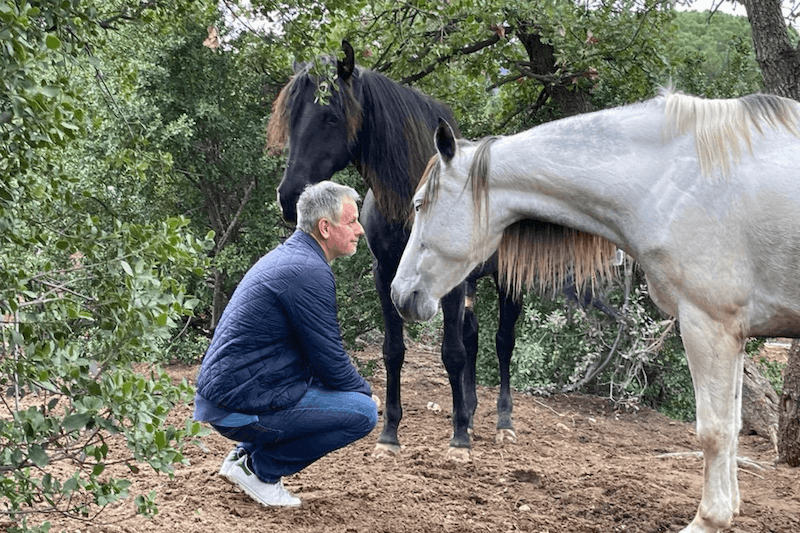Beyond words: exploring the world of animal communication with Shaïna Lebeau

In a world where animal welfare is becoming increasingly important, animal communication is emerging as a fascinating practice that enables genuine dialogue between humans and pets.
In our new series dedicated to alternative therapies, Monaco Tribune meets professionals who are redefining our approach to well-being. After exploring essential oils with Peter Pinville, an aromatherapist and naturopath, we continue with this second instalment, diving into the little-known world of animal communication, an approach that is revolutionising our relationship with our four-legged companions.
The art of listening beyond sight and sound
“Animal communication is, above all, about listening — listening to what the animal needs to express,” says Shaïna Lebeau, animal communicator and author, whose words resonate like a mantra. Alongside Florent Richet, her partner and collaborator, she sheds light on a practice that is often misunderstood.
It’s the best day of their life
Contrary to popular belief, animal communication is not some mystical practice, but an exchange based on telepathy and the transmission of thoughts through brainwaves. “Animals always have brainwaves between 7 and 13 Hz, whether they are sleeping or playing. In humans, this frequency corresponds to a state of light relaxation,” Shaïna says. It is in this state that the connection is made.
A strict ethical code
Before each session, Shaïna Lebeau applies a strict ethical code that she has developed herself. Four important questions are asked of the owners, the last of which is particularly revealing: “Are you ready to support everything that your pet suggests, not only for them but also for yourself?”
“If I don’t get a clear ‘yes’ to all four questions, I prefer not to do the session, out of respect for the animal,” she explains. A mutual commitment is crucial, because, contrary to what we might think, “the animal will always agree, they are always eager to express themselves. It’s all pets look forward to — it’s the best day of their life.”

A session in four stages
A comprehensive animal communication session lasts between two and three hours and unfolds in four distinct stages. First, the pet expresses itself freely for about an hour and a half. Then, everything it has shared is translated to the humans in the household. The third part is like “a family meeting,” where everyone can ask questions. Finally, a written report is provided, highlighting the pet’s suggestions.
“The pet will talk about their favourite subject: the humans they live with. They will talk about themselves, but ultimately very little,” Shaïna explains. A revelation that often surprises owners who discover just how intimately their companion knows them.
Why was my pet there all this time?
Varied yet profound requests
The reasons why owners seek animal communication are numerous. “We are often contacted for behavioural issues, such as a tendency to run away or occasionally aggression, or conflicts between pets,” Florent explains. But the humans’ concerns often differ from what the animal truly wants to express.
Shaïna adds: “I get many calls about end-of-life situations because people don’t want to let go of their sick pets. It’s very difficult. They have a moment of realisation while asking, ‘But why was my pet there all this time? I can’t let them go; they’re my life-long companion.'”
“How could he know? He wasn’t with us.”
Paradoxically, some owners claim that their pet “is fine, they’re very affectionate, happy, not aggressive,” and therefore have “nothing to say, nothing to express.” However, even behind seemingly well-adjusted behaviour, “there is always something profound,” Florent adds.
Surprising revelations
Pets perceive aspects of our lives that we may sometimes be unaware of ourselves. Shaïna recalls a recent consultation where a dog revealed its owner’s relationship difficulties with her father, who had left when she was a child and how this affected her current relationships.
How can they perceive such subtle things? Florent explains: “The animal has access to our thoughts, words and emotions. They have access to everything, they know us, they have access to our subconscious, simply because they are not disrupted by two things we have: our mind, which makes us ask questions, and our ego, whether inflated or diminished, which is the result of all our life situations and hardships.”
Even more astonishing, Shaïna explains that “pets are with us non-stop, whether we are physically present with them or not, they capture our thoughts, our moods, our emotions, and everything we do. They are here to accompany us.” She illustrates this with the story of a cat that knew its owner had met her ex-partner again, even though she denied it: “How could he know? He wasn’t with us,” the owner wondered.

A path to shared well-being
The messages conveyed by pets are always imbued with a positive intention. “The animal is straightforward, they are entirely benevolent, without judgement — what they feel is good. So, they say it, they express it,” explains Florent. Their authenticity is “a real gift for humans,” allowing, when the advice is followed, a “shared well-being, both for humans and animals.”
From curiosity to career
The paths that Shaïna and Florent have taken represent two different journeys toward animal communication. For Shaïna, her ability became clear in childhood when she realised that others did not hear animals as she did. A traumatic event led her to seek refuge in this privileged connection: “At the age of eight, I decided not to speak until my adolescence. I stayed connected with animals, but much less so with humans.”
Florent, on the other hand, represents the sceptic who was converted: “I was completely disconnected from animal communication because I was one of those people who didn’t think it was possible to communicate with animals.” During a workshop with Shaïna, everything changed. “I listened to my dog and they told me many things… They told me truths that I wasn’t necessarily aware of.”
A complementary practice to veterinary medicine
More and more veterinarians are showing interest in this approach and are taking training courses. “We really do have more and more veterinarians attending our workshops,” Shaïna says happily. Florent adds: “A Cartesian thinker isn’t necessarily closed to beliefs, but they seek to understand.”
The synergy between scientific and intuitive approaches opens up new perspectives for animal well-being. “We are the opposite of the scientific aspect because we’re not thinking, we’re feeling. And both elements are complementary,” explains Shaïna.
For those who wish to improve their connection with their pet, Shaïna advises “talking more to your pet” and taking time to stroke it while closing your eyes to ‘feel’. Florent adds the importance of “being present” with your pet, even just for five minutes, being fully conscious and not thinking about anything else.
The future of animal communication
Given the growing enthusiasm for this practice, Shaïna and Florent hope for a more scientific recognition of animal communication to avoid misuse. “That’s why we are strongly advocating for scientific recognition,” Florent explains.
For Shaïna, the future lies in the Native American legend of the hummingbird, which has become the symbol of their school. She says: “A little hummingbird, during a forest fire, flies back and forth between the lake and the flames, releasing water drops from its beak. When an armadillo points out that it won’t be able to put out the fire alone, the hummingbird simply replies: ‘I know, but I’m doing my part.’”
The philosophy guides their teaching: “All the people who come to our workshops are hummingbirds. Each in their own way, they will be able to do their part so that pets assume their rightful position in homes.”
To learn more about animal communication or explore the training courses offered by Shaïna Lebeau and Florent Richet, you can consult their book or visit their website.













